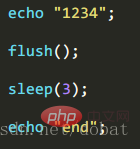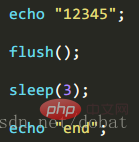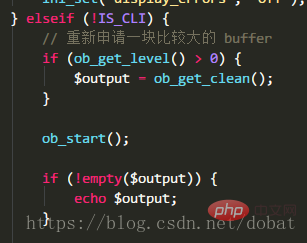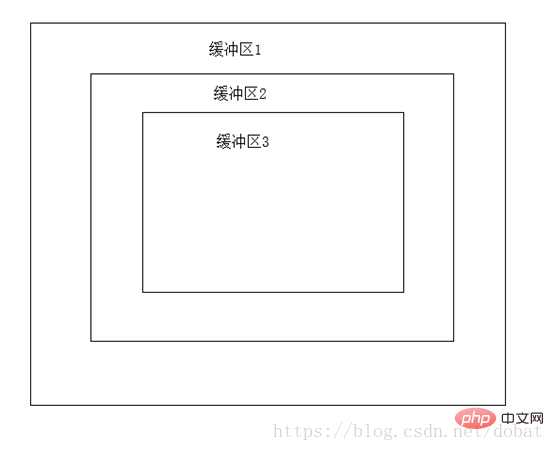How to close buffer in php
php method to close the buffer: 1. Open the PHP installation directory, find and open the configuration file "php.ini"; 2. In the configuration file, find the "output_buffering" item, and set the value of this item Just set it to "Off".

The operating environment of this tutorial: windows7 system, PHP7.1 version, DELL G3 computer
PHP buffer ( buffer)
The script output information is first put into the buffer. Only when the buffer is full or the script is finished running, the data will be transferred to the next stage. You can find the output_buffering setting item in the configuration file php.ini. My default configuration (Windows/XAMPP v3.2.2) is 4096

If set to On, the buffer is available and has no size limit;
If set to Off, the buffer is unavailable;
If set to an integer, the buffer The area is available and is the set size, in bytes.
It should be noted that ini_set cannot set the buffer size. When initializing the script running environment, the buffer has been defined; in cli mode, the default output_buffering is Off. .
Then the question is, what is the difference between closing and opening the buffer? What does the initial buffer size do? The cli mode is turned off by default. Can it be turned on if business needs it? What are the benefits of the cache area?
1. What is the difference between closing and opening the buffer?
Pass code inspection
When output_buffering is configured as 4096, run the code

Output result: After waiting for 3 seconds , output start and end at the same time
When Output_buffering is configured as Off, run the same code
The output result: start is output first, and after waiting for 3 seconds, end
## is output #Looking at it alone, the results are exactly the same~ But observing its operation process, I found surprising differences. If buffering is turned off, "start" is output first, and then "end" is output after waiting for 3 seconds. When the buffer is turned on, it will wait for the script execution to complete and output the results together In this example, flush is used to refresh the apache buffer, similar to allowing the PHP buffer to establish a direct connection with the browser, so that our attention Be able to focus on the PHP buffer itself. Through a vivid example, PHP's buffer is like a big house. Every time the output function such as echo is executed, the data is thrown into this big house until the script execution is completed or the ob_flush function is executed. The data is released from the big house and thrown into the WebServer buffer. After closing the PHP buffer, the echo function is executed. What should I do if there is no big house to put it in? I have to hand it over directly to the WebServer buffer. Through examples and code execution results, we can understand that the so-called PHP buffer is a data storage hub developed by PHP itself, and a series of ob functions operate for this purpose. (Cite a few example functions) ob_clean(); //Delete the contents of the internal buffer, do not close the buffer (no output). ob_end_clean(); //Delete the contents of the internal buffer and close the buffer (no output). ob_get_contents(); //Returns the contents of the buffer, does not output ob_get_length(); //Returns the length of the internal buffer. If the buffer is not activated, this function returns FALSE .2. What is the role of the initial buffer size?
Change output_buffering from 4096 to 5 to facilitate test executionExecution code

3. The cli mode is turned off by default. Can it be turned on if business needs it?
This question can be supplemented. In non-cli mode, if php.ini sets the buffer to be closed, but the business needs to use the buffer, what should I do? Is it possible to change the configuration? Of course it won't be that difficult. At this time, another ob function comes, ob_start(); //Open an output buffer. All output information is no longer sent directly to the browser, but saved inside the output buffer. Now that we know that PHP buffer is similar to the concept of temporary data storage area, let’s go back and look at the TP5 source code.
Let’s first look at the explanation of ob_get_level and ob_get_clean functions
ob_get_level(): Returns the nesting level of the output buffering mechanism.
ob_get_clean(): Get the contents of the current buffer and delete the current output buffer.
We can also learn a thing or two from the code. If the level is greater than 0, get the contents of the buffer and delete the buffer, and then open a new one through ob_start. This is also in line with the instructions in the comments. "reapply".
The so-called nesting is explained here. As for when the value of level will be 0, and what is it if it is non-0, please turn off php.ini output_buffering and output to see the result. In addition, ob_start multiple times and ob_get_level multiple times, let’s try to compare the output results.
Let’s take a look at the two models first


4. What are the benefits of the cache area?
PHP output data is sent to WebServer. If echo is executed and sent once, this increases resource consumption. It is more efficient to store it in memory and send it uniformly. Web requests contain HTTP headers, and there must be no output before the headers are set. The PHP buffer does this work for us, outputting various data before sending the header. The buffer will first send the header information to WebSever, and then send the data packets uniformly. Recommended learning: "PHP Video Tutorial"
The above is the detailed content of How to close buffer in php. For more information, please follow other related articles on the PHP Chinese website!

Hot AI Tools

Undresser.AI Undress
AI-powered app for creating realistic nude photos

AI Clothes Remover
Online AI tool for removing clothes from photos.

Undress AI Tool
Undress images for free

Clothoff.io
AI clothes remover

Video Face Swap
Swap faces in any video effortlessly with our completely free AI face swap tool!

Hot Article

Hot Tools

Notepad++7.3.1
Easy-to-use and free code editor

SublimeText3 Chinese version
Chinese version, very easy to use

Zend Studio 13.0.1
Powerful PHP integrated development environment

Dreamweaver CS6
Visual web development tools

SublimeText3 Mac version
God-level code editing software (SublimeText3)

Hot Topics
 1667
1667
 14
14
 1426
1426
 52
52
 1328
1328
 25
25
 1273
1273
 29
29
 1255
1255
 24
24
 PHP: A Key Language for Web Development
Apr 13, 2025 am 12:08 AM
PHP: A Key Language for Web Development
Apr 13, 2025 am 12:08 AM
PHP is a scripting language widely used on the server side, especially suitable for web development. 1.PHP can embed HTML, process HTTP requests and responses, and supports a variety of databases. 2.PHP is used to generate dynamic web content, process form data, access databases, etc., with strong community support and open source resources. 3. PHP is an interpreted language, and the execution process includes lexical analysis, grammatical analysis, compilation and execution. 4.PHP can be combined with MySQL for advanced applications such as user registration systems. 5. When debugging PHP, you can use functions such as error_reporting() and var_dump(). 6. Optimize PHP code to use caching mechanisms, optimize database queries and use built-in functions. 7
 PHP and Python: Comparing Two Popular Programming Languages
Apr 14, 2025 am 12:13 AM
PHP and Python: Comparing Two Popular Programming Languages
Apr 14, 2025 am 12:13 AM
PHP and Python each have their own advantages, and choose according to project requirements. 1.PHP is suitable for web development, especially for rapid development and maintenance of websites. 2. Python is suitable for data science, machine learning and artificial intelligence, with concise syntax and suitable for beginners.
 PHP vs. Python: Understanding the Differences
Apr 11, 2025 am 12:15 AM
PHP vs. Python: Understanding the Differences
Apr 11, 2025 am 12:15 AM
PHP and Python each have their own advantages, and the choice should be based on project requirements. 1.PHP is suitable for web development, with simple syntax and high execution efficiency. 2. Python is suitable for data science and machine learning, with concise syntax and rich libraries.
 PHP in Action: Real-World Examples and Applications
Apr 14, 2025 am 12:19 AM
PHP in Action: Real-World Examples and Applications
Apr 14, 2025 am 12:19 AM
PHP is widely used in e-commerce, content management systems and API development. 1) E-commerce: used for shopping cart function and payment processing. 2) Content management system: used for dynamic content generation and user management. 3) API development: used for RESTful API development and API security. Through performance optimization and best practices, the efficiency and maintainability of PHP applications are improved.
 The Enduring Relevance of PHP: Is It Still Alive?
Apr 14, 2025 am 12:12 AM
The Enduring Relevance of PHP: Is It Still Alive?
Apr 14, 2025 am 12:12 AM
PHP is still dynamic and still occupies an important position in the field of modern programming. 1) PHP's simplicity and powerful community support make it widely used in web development; 2) Its flexibility and stability make it outstanding in handling web forms, database operations and file processing; 3) PHP is constantly evolving and optimizing, suitable for beginners and experienced developers.
 PHP and Python: Different Paradigms Explained
Apr 18, 2025 am 12:26 AM
PHP and Python: Different Paradigms Explained
Apr 18, 2025 am 12:26 AM
PHP is mainly procedural programming, but also supports object-oriented programming (OOP); Python supports a variety of paradigms, including OOP, functional and procedural programming. PHP is suitable for web development, and Python is suitable for a variety of applications such as data analysis and machine learning.
 PHP vs. Other Languages: A Comparison
Apr 13, 2025 am 12:19 AM
PHP vs. Other Languages: A Comparison
Apr 13, 2025 am 12:19 AM
PHP is suitable for web development, especially in rapid development and processing dynamic content, but is not good at data science and enterprise-level applications. Compared with Python, PHP has more advantages in web development, but is not as good as Python in the field of data science; compared with Java, PHP performs worse in enterprise-level applications, but is more flexible in web development; compared with JavaScript, PHP is more concise in back-end development, but is not as good as JavaScript in front-end development.
 PHP and Python: Code Examples and Comparison
Apr 15, 2025 am 12:07 AM
PHP and Python: Code Examples and Comparison
Apr 15, 2025 am 12:07 AM
PHP and Python have their own advantages and disadvantages, and the choice depends on project needs and personal preferences. 1.PHP is suitable for rapid development and maintenance of large-scale web applications. 2. Python dominates the field of data science and machine learning.




